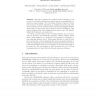Free Online Productivity Tools
i2Speak
i2Symbol
i2OCR
iTex2Img
iWeb2Print
iWeb2Shot
i2Type
iPdf2Split
iPdf2Merge
i2Bopomofo
i2Arabic
i2Style
i2Image
i2PDF
iLatex2Rtf
Sci2ools
VMCAI
2009
Springer
2009
Springer
Finding Concurrency-Related Bugs Using Random Isolation
This paper describes the methods used in Empire, a tool to detect concurrency-related bugs, namely atomic-set serializability violations in Java programs. The correctness criterion is based on atomic sets of memory locations, which share a consistency property, and units of work, which preserve consistency when executed sequentially. Empire checks that, for each atomic set, its units of work are serializable. This notion subsumes data races (single-location atomic sets), and serializability (all locations in one atomic set). To obtain a sound, finite model of locking behavior for use in Emdevised a new abstraction principle, random isolation, which trong updates to be performed on the abstract counterpart of each randomly-isolated object. This permits Empire to track the status of a Java lock, even for programs that use an unbounded number of locks. The advantage of random isolation is that properties proved about a randomly-isolated object can be generalized to all objects allocated ...
Related Content
| Added | 20 May 2010 |
| Updated | 20 May 2010 |
| Type | Conference |
| Year | 2009 |
| Where | VMCAI |
| Authors | Nicholas Kidd, Thomas W. Reps, Julian Dolby, Mandana Vaziri |
Comments (0)

